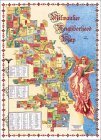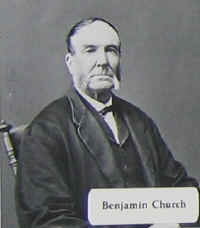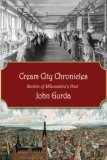Benjamin Church, a young carpenter from New York, arrived in what would become Milwaukee on November 15, 1835, when Wisconsin
was still a territory. A pioneer carpenter and master
builder, he helped build hotels,
houses and more. He was born in 1807 in or near New Paltz,
Ulster County,
New York, and came west via Chicago. He settled on the west side of the Milwaukee River in
Kilbourntown, one of three towns that were merged to become Milwaukee in 1846.
He and his wife Permilia had six children including the eldest Ann
Maria "Hannah" Church who married Sherman A. Bradley. A Greek Revival home that
Benjamin built for his family in 1843-44 was rescued and moved to Estabrook Park in
Shorewood in 1938, and in 1972 was added to the National Register of Historic Places. He
was a Mason and a member of Milwaukee's Old Settlers Club.
GO TO: Church House | History | Church Family | Genealogy
| Maps
Benjamin Church House [ Top ]
Benjamin
Church gained his place in history thanks to the distinctive Greek Revival home that he
built on Fourth Street between Cherry and Galena Streets in Kilbourntown, part of early
Milwaukee. Four columns graced the portico. He brought this new style with him from his
native New York. See photos of the Benjamin
Church House.
Greek
Revival Style in architecture became so popular it was also known as national
style. It connected the democracy of early Greece with the democracy of the new American
nation. It spread west through New York to Midwest America and beyond. Shown in 41
illustrations.
Church House
in Historic American Building Survey: with four architectural drawings from
1933 survey-- including interior floor plan and exterior details -- plus one photo
of its condition prior to rescue and two data pages that connect the house with the Binzel
family.
As the second
oldest structure still standing in Milwaukee in 1938, the Benjamin Church
House drew the attention of the Milwaukee County Historical Society and the City Council
for restoration as a landmark.
The eleventh-hour
rescue of the Benjamin Church homestead, the role of the bricks stamped
J.A.M. 1844 and the move to Estabrook Park are recounted in Frederic Heath's article,
December 1947 issue, Wisconsin Magazine of History, pages 80-83. Photo shows
its Greek temple style.
Remember
When? Church House: a large photograph from the Milwaukee Journal when
the house was relocated in 1938, with brief details on the history of the house after it
left Church family ownership
The restored house was dedicated
September 14, 1939, with Frederic Heath as emcee. A fantasy pageant by Myrtyl Ross was
performed.
Church
or Kilbourntown House: due to its distinctive Greek Temple style and
constuction materials including hand-hewn timbers and local bricks dated to 1844, the
house was rescued in 1938. The Colonial Dames of America helped by furnishing the house
with period pieces.
Benjamin
Church Residence 1844: current photo of the house in Estabrook Park, with
note on use of cream city bricks in its construction, plus a larger photo. The house is
included on key lists of important structures in Milwaukee architecture
and historic
Milwaukee
Cream
City Bricks were a famous Milwaukee product made from the red clay of western
Lake Michigan and used for many city buildings, and more on the composition and color of Cream City brick.
The Benjamin
Church House, once moved to Estabrook Park, was "the pride of the
city" in Milwaukee.
Kilbourntown
House saved by move north: a 1995 Milwaukee Journal-Sentinel story
gives the history of the house along with list of other pre-Civil War houses in Milwaukee.
Kilbourntown
House: one of three pioneer houses operated today by the Milwaukee Historical
Society, with details on visiting times. The alternative name for the house comes from the
name of Byron Kilbourn's early town on the west side of the Milwaukee River.
On
the National Register of Historic Places: recognized for its
Greek Revival architecture, the Church House of Milwaukee was added to the national
register in 1972. See all Registered
Historic Places in Milwaukee County. See a summer photo and more photos.
Church
House on museumsusa.org: with notes about its quality 19th century
furnishings, and a mention in the December 1940 issue of the Wisconsin Magazine of
History [p. 243] that House and Garden magazine had an
illustrated article by Walter J. Harris on the Benjamin Church House in its September 1940
issue.
Church
House Wikipedia article with details on its owners, the Church and Binzel
families. Article also at Answers.com
with photo showing front and bedroom wing. Written by Barbara Bradley Petura.
Kilbourntown House in
Winter: a 1953 photo of the Benjamin Church house in Estabrook Park with
skiff of snow. More
details.
Benjamin Church's
Kilbourntown House: scroll down for two Fall 2006 photos of the house, one of
a column, another of the portico
| Benjamin
Church House exterior and interior photographs, taken by Barbara Bradley
Petura, July 2007, plus one of Benjamin Church himself, the pioneer who built the house. Dining
Room of Kilbourntown House: inside the house Benjamin Church built,
photo courtesy of Ms. Crow, a former tour guide there
Being a
Church House Docent: Aaron Stockham, a history graduate students,
describes leading summer tours at the Church House.
The Herb
Society of America in 2000 created a "kitchen herb garden" for the
little white house.
Fourth
Street Neighborhood: photo looking north from Galena Street in 1895. The
Benjamin Church House -- his family residence -- was originally located on Fourth just
south of Galena, an address now 1533 Fourth Street across from Court Street, as shown on
this map
Milwaukee Streets:
name changes vital to understanding old records in view of today's city |

ORDER
The Milwaukee
Neighborhood Map
(Maps & Atlases)

ORDER
Milwaukee
Streets:|
The Stories Behind
Their Names
|
Benjamin Church (1807-1887) in Documents [ Top ]
Benjamin Church arrived in Milwaukee on November 15, 1835, his
membership records in the city's Old Settlers Club
state.
Benjamin
Church lived in the West Ward or Second Ward on the west side of the
Milwaukee River, 1840 Census and 1850 Census records
show. See his family
of five in 1850 on a transcribed 1850 Census page. The Robert Luscombe family
was next door. Read on Wikipedia a biographical sketch about Benjamin F. Church
written by the author of this webpage.
Benjamin & Family
as seen in the 1850 and 1860 census records including his wife Permilia and their
children Ann Maria, later called Hannah, Mary or Maria; Ann Augusta, later called Anna,
Annie and Nannie; Charles B.; John; and Susan. A sixth child, a son, died young. The
family in 1860 and 1870 also included Hannah's husband Sherman A. Bradley, a carpenter
from Connecticut.

Photo courtesy of the Milwaukee
County Historical Society.
|
|
Benjamin Church, builder, living on Fourth Street in Ward 2 as
listed in the Milwaukee
City Directory 1848-49 Benjamin Church, builder, on Fourth
between Cherry and Galena, as listed in the 1858
Milwaukee Directory
Benjamin was a member of the Masons, Milwaukee Chapter 1,
with Byron Kilbourn, founder of Kilbourntown on the west side of the Milwaukee River and
eventually part of Milwaukee. Church was aligned politically with Kilbourn. |
In 1836, Church was boss carpenter for Kilbourn's Washington
House, a hotel later the Republican House. In his Pioneer History of
Milwaukee p. 104, James
S. Buck says Church was contractor for the Washington House that opened in
1837, built by Archibald Clybourn. On p. 70, Buck lists Benjamin Church among those who
arrived in Milwaukee in 1835. On p. 92, Buck lists Benjamin Church among the 20 men who
were "boss carpenters" in charge of construction in early Milwaukee.
In February 1850 in Madison, Benjamin Church helped establish the Grand
Chapter of Royal Arch Masons for Wisconsin, pp. 1288-1289.
On January 6, 1859, Hannah
M. Church, the eldest daughter of Benjamin and Permilia C. Church, married
Sherman A. Bradley, born in 1835 near New Haven, Connecticut, records show.
William
De Loss Love, noted Congregational clergyman, author and abolitionist,
married Hannah and Sherman. He served Milwaukee's Spring Street Congregational Church
from February 1858 through 1871. Its new Church
at 6th and Spring streets had first services in 1857. Confusion about its location occurs
because Spring
Street was later renamed Grand Avenue, then West Wisconsin Avenue.
Benjamin's second daughter, Anna
Augusta Church, on April 14, 1875, married Henry
Moore. She was called Anna, Annie or Nannie.
On September 10, 1879,
Benjamin's youngest son John
Church married Margaret
Ledge Gunyon. Family sources say her middle name was Legarde and she was
Robert Gunyon's adopted daughter.
By the 1880
US Census, Benjamin was retired and living with his son John Church and
John's wife Maggie who was born in England
In an 1881 listing, Benjamin was an Old Settlers Club
member, having arrived in Milwaukee before January 1, 1843. His dates: Born July 23, 1807, Ulster County. NY. Came to Milwaukee November 15, 1835.
Wisconsin
Name Index: click to search the index for a listing of the biographical
sketch of Benjamin Church prepared by the Federal Writers Project (Wis.) between
1935-1942.
Benjamin F. Church died
November 29, 1887, and was interred on December 1, 1887, in the family plot in Section 16 of
Milwaukee's historic Forest
Home Cemetery.
In his book Pioneer History of Milwaukee, p. 281,
James Smith Buck lists Benjamin Church among those members of the Pioneer and Old
Settlers Clubs at whose funerals he officiated as marshall. Buck was a New
Hampshire.native.
Benj. Church's Parents & Descendants [ Top ]
Hannah Baker Church is
mentioned as an early Friends minister in the book Quaker history and genealogy of the
Marlborough Monthly Meeting, Ulster County, N.Y., 1804-1900, with an excerpt online.
Caleb Church's descent from
Richard Church of Plymouth, Mass., has been suggested but lacks documentation. Caleb,
Hannah and their children including Benjamin are in the Unplaced Members section of the
book Descendants
of Richard Church of Plymouth, Mass. This Richard Church arrived at the
Massachusetts Bay Colony from England in 1630 and moved to Plymouth in 1632.
Jesse
Charles Bradley: grandson of Benjamin Church through his daughter
Hannah M. Church who married Sherman A. Bradley. Active in Masonic groups, Jesse
here is Worthy Grand Patron of the Order of Eastern Star, Wisconsin Grand Chapter. In 1905
he was elected Grand Master of the Free and Accepted Masons of Wisconsin. He married
Caroline Belle Speich. Her father Joachim came from the Glarus
Valley in northeast Switzerland; her mother Marianna Stocker came from that country's Simme River Valley in Canton Bern.
John Church,
youngest son of Benjamin and Permilia Church, married Margaret or Maggie Legard, a
relative of William Legard of Yorkshire, England. John was a tax assessor for Milwaukee.
Descendents note that Maggie was adopted by Robert
Gunyon whose will is mentioned here. The Edgar B.
Church mentioned is John
and Maggie's youngest son.
Robert
Gunyon Church (1882 - 1944?): grandson of Benjamin Church through his
youngest son John. Robert G. Church was the father of Robert Smith Church and several
other children.
Robert
Smith Church (1921-2000): a great-grandson of Benjamin Church, his
obituary mentions his wife Helen; sons William, John and Paul; and daughter Anne.
Milwaukee History [ Top ]
Timeline of Milwaukee History:
from its founding to today -- follow links to the "bridge war,"
Socialist era, more
Beginnings,
Dates and Events:
Chapter 16 of The History of Milwaukee, City and
County, Volume I, [pdf format]
edited by popular historian William George
Bruce.
Letters from Early
Milwaukee: Increase A. Lapham's 1836-1846 letters portray rapid growth of the
young city, much more
Milwaukee
1835-1851: part of an emigrant's handbook from this period, showing the
city's economy, imports and exports, ship building, the 50,000 people arriving by ship in
1850, and more. The ad section at the end shows
the city's goods and services in 1851.
Solomon Juneau:
French-Canadian fur trader who founded Juneautown on the east side of the Milwaukee River,
an area merged into Milwaukee in 1846
Byron
Kilbourn: Connecticut native and developer who founded Kilbourntown on the
west side of the Milwaukee River, merged into Milwaukee in 1846
George H. Walker: In 1835 founded Walker's Point
on the south side of town, merged into Milwaukee in 1846
Milwaukee's Competing
Founders: a brief look at the early days of the city plus the return Byron
Kilbourn's remains to Milwaukee
Links to the
Past for Milwaukee: source for genealogy and history with early census
records, biography indexes, directories, maps, more
